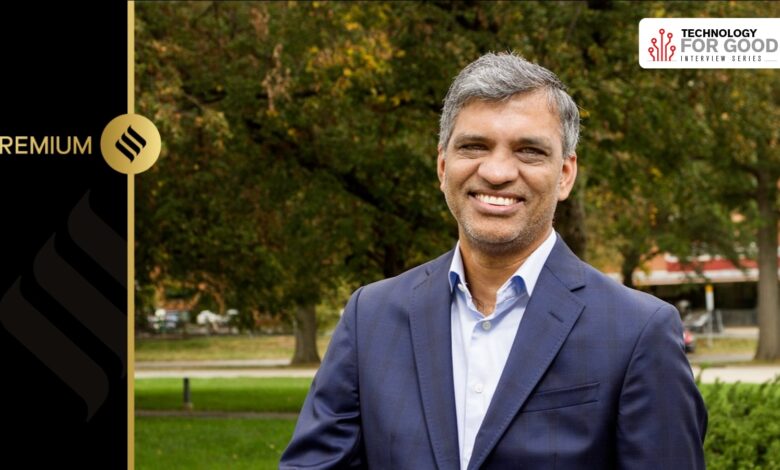AI is a catalyst in our journey to net zero: Mahesh Ramanujam, CEO, Global Network for Zero | Technology News

Mahesh Ramanujam is the co-founder and CEO of Global Network for Zero (GNFZ), an independent net zero certification body based out of the US, helping businesses, governments, and communities achieve net-zero carbon emissions. Mahesh works on creating a global framework for decarbonisation, encouraging industries to adopt sustainable practices.Mahesh is also the former president and CEO of the US Green Building Council (USGBC), and played a significant role in promoting LEED (Leadership in Energy and Environmental Design), a green building certification, across the globe.A graduate of Annamalai University with a degree in Computer Engineering, Mahesh spoke to on climate tech innovations that caught his eye, how the green building concept has taken off across the globe, and how AI is likely to help companies and organisations in their journey to net zero. Edited excerpts:Mahesh Ramanujam: The first is solar power. At the end of the day, renewable energy itself is a big climate innovation and is the most practical climate tech on the ground, given our goal to get to 500 gigawatts 2030. Solar power has scaled up, responding to market needs, and is addressing the energy demand and supply gap on the ground.
Solar energy is great, but its impact would be limited if you do not integrate it with a good battery energy storage system. Given India’s geography, extreme climatic conditions, and energy demand variation during summers and winters, a good battery energy storage system is crucial to maintaining grid stability. We need to look at a system that will store excess energy from renewables, reduce energy costs, and discharge stored energy during high demand. There is also the arbitrage opportunity; if you price it appropriately and if you can release the energy during peak demand, compensating for other economic shocks the industry might face.
The third tech is passive cooling, and, of course, thermal management is coming into focus. In India, we have relied on putting up more and more air conditioners. The challenge with active cooling is that it puts a significant load on energy and negatively impacts thermal comfort. So when you are in a building you feel like you are constantly moving between hot and cold streams which reduces your comfort. So the whole idea of passive cooling with phase change materials (PCM) is that you integrate these materials into the building so that they absorb and release heat to regulate indoor temperatures and reduce the need for mechanical cooling.
Venkatesh Kannaiah: Do you foresee a reduction of funds flowing into climate tech following the arrival of President Donald Trump?
Mahesh Ramanujam: The Trump adminration might not be friendly to the traditional climate language that we are all used to. However, you know that climate financing is market-driven and so private investors will continue to invest. They may not use the earlier terminology of climate, green and sustainability and might use words like ‘efficiency’ or ‘future proofing’ to make it more palatable to the times we live in.Story continues below this ad
Venkatesh Kannaiah: Can you tell us about some out-of-the-box climate/sustainability tech startups that have caught your eye?
Mahesh Ramanujam: There are quite a few. There is a company called ZeroAvia, providing hydrogen electric power trains for zero-emission aircraft. ZeroAvia’s tech uses hydrogen fuel cells to generate electricity, powering electric motors with water as the only product, offering a sustainable alternative to traditional jet fuel.
Pachama in San Francisco is using AI and remote sensing to protect forests and natural habitats and to generate carbon credits, addressing the problem of verification and validation of carbon credits. Using tools like satellite imagery, remote sensing, and machine learning, Pachama measures and monitors carbon storage in forests with accuracy.
There is Solugen in Houston, using bio-based chemicals without fossil fuels, helping to address industrial emissions solutions. It is a bioindustrial startup transforming the chemical manufacturing industry producing sustainable, bio-based alternatives to traditional petrochemicals.
Rumin8 is an Australian startup tackling agricultural emissions developing livestock supplements that suppress methane production in animals like cattle and sheep. The company’s tech inhibits methane-forming microbes in the animal’s gut.Story continues below this ad
Finally, there is Charm Industrial, which is collaborating with the US Forest Service and converting forest waste into bio-oil and then sequestering the remaining waste underground to remove carbon from the atmosphere. It is a carbon removal and carbon sequestration technology. Charm injects the carbon-rich bio-oil into geological formations for long-term storage.
Venkatesh Kannaiah: Tell us about your experience in ‘green buildings’ work across India. How many are certified and how does it work?
Mahesh Ramanujam: A green building is a structure designed, constructed, and operated in an environmentally responsible and resource-efficient manner. They aim to minimise their negative impact on the environment while enhancing the health and well-being of their occupants. Such a sustainability idea is not alien to India. With scarcity of land, without the luxury of air conditioning, and since the houses were passed on to us from generation to generation, the idea of sustainability was in-built.
This green building concept has forced the architects, engineers and construction leaders to think of buildings as an integrated system. Earlier, both structural engineers and mechanical or electrical engineers had their own plans. All this would lead to an excess consumption of materials and enormous wastage. Now, with the green buildings concept, they are using materials that actually have a low carbon footprint and are trying to reduce emissions and energy load during the construction and, later, operation of the building. We must recognise that emissions from the built environment contribute about 40 percent of global emissions.
Venkatesh Kannaiah: How many buildings are ‘green’ in India and what is the global estimate?
Mahesh Ramanujam: In India, we have more than 5,000 buildings — from big airports to small offices — with green building certification Globally, we have more than 110,000 buildings that are, I would say, LEED certified. LEED certification is a globally recognised rating system for green buildings developed the US. Green Building Council. There are close to a million buildings that are green certified or comply with various green building design guidelines. It is a phenomenal progress that has been attained in the last 30 years. And now, all these buildings are moving towards what we call net zero standards.Story continues below this ad
Venkatesh Kannaiah: So when you say a net zero building, is it different from a green building?
Mahesh Ramanujam: I think it is a journey. All green buildings have been on a journey to get to net zero, but they have not arrived at it yet. But net zero is an end state. It is basically reducing your scope one, scope two, and scope three emissions to zero.
Venkatesh Kannaiah: How is AI changing the climate tech space, particularly the net zero reporting or certification segment?
Mahesh Ramanujam: Most people forget that software alone is not enough to drive the transformation on the ground because it is a change in behaviour that we are expecting. A transformation or transition to a greener, cleaner, and a zero emissions world requires changes in behaviour.
When I look at AI and net zero reporting frameworks, I think AI might be able to induce the required behavioural changes. It could be a kind of catalyst. When we are able to provide an intervention in a very simplic and a very targeted manner, that’s when we can transform behaviour and that is where AI will come in. AI would not only provide customised solutions, it will also draw on the larger experience of the world. So you will not only get a customised solution, it will provide a pathway to the customised solution. The solution would be optimised cost, region or your particular situation, with AI guiding you on how to reach the optimal solution.
Venkatesh Kannaiah: Can you talk about how tech like IoT is changing the sustainability space?
Mahesh Ramanujam: We live in the era of sensors and IoT devices. And so we have a billion devices connected at any point of time to the network. AI can find and help us interpret data coming from all these multiple device points. It also allows you to determine the optimal way to deploy these devices.Story continues below this ad
The data collection and this AI layer above it will tell you that you probably don’t need that many devices. For example, you may not really need that many smart windows, motion sensors, or devices related to EV charging stations. You will finally find through AI that these devices could be optimised, and you can actually reduce the footprint of these electronic devices while getting more value out of them. That is where I see this going.
Obviously, AI is going to help with data consolidation, data synthesis, and for interpretation of data to drive decisions. That, to me, is happening already. Where it is going is that you will be able to optimise design and you will also be able to identify vulnerabilities. It can also give feedback to the manufacturer to optimise his tech. Right now, that close-loop feedback is not happening, so the manufacturer has no clue how his sensors are being used.
However, once you enable an IoT device, you are also making your infrastructure vulnerable. It can be targeted for cyber attacks or potential misuse. AI can detect those anomalies and help to go into preventive maintenance or predictive monitoring. The moment you connect so many devices, it doesn’t come free. It comes with a price, and that price is safety. Safety becomes a challenge which AI can solve as we connect these devices to an AI-based engine which would continuously interpret and monitor the same.
Venkatesh Kannaiah: What about blockchain?
Mahesh Ramanujam: As for blockchain, I am not yet seeing a good example of a blockchain solution in the sustainability monitoring space. I think the tech is good, but it has its own stigma, if I may say so. Also, a lot of people confuse blockchain with crypto. I have not seen good use cases around blockchain and climate tech solutions using blockchain have not happened yet, and I doubt whether it could be scalable.Story continues below this ad
Venkatesh Kannaiah: Is the business case for climate tech improving?
Mahesh Ramanujam: I feel that many of the climate tech products and startups are underestimating the extent of the climate problem. Most people confuse their good intent with what actually scales in the market. That’s why we need to think disruptive, like, for example, the green building concept. It was a concept on paper 30 years ago, and now it has taken off. The business case for climate tech is always challenging. Scalability and profitability is an issue. Now, the only workable things I have seen are solar, battery, and wind energy. Even wind energy took a long time. Hydrogen has potential. However, you have to understand why and when businesses will find it attractive to shift to a different technology. One has to understand market mechanisms before one thinks of tech.







